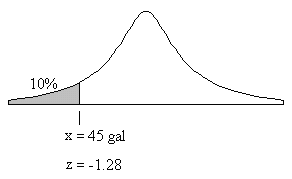Solution:
The diagram shows a normal distribution describing the actual fill amounts. We must find the mean fill μ (ie. the location of the peak) which would result in a fill of less than 45 gallons only 10% of the time. To do this we transform our normal distribution to the standard normal distribution using this change of variable

where z is the standard normal variable whose distribution is given in tables, x is the 45 gallon fill per barrel in question, μ is the mean fill per barrel (unknown), and σ is the standard deviation of the fill per barrel. The standard normal distribution table shows that 10% of the area of the normal curve lies below the value z = -1.28. Solving for μ gives

Thus the mean fill must be set at 45.387 gallons/barrel.
-
Begin by finding the fill μ which would result in a fill of less than 45 gallons only 10% of the time with the new attachment. Using the new numbers

This means that the machine can be set at 45.119 gallons/barrel rather than the previous 45.387 gallons/barrel. This is a saving of 0.268 gallons/barrel or a savings of $0.737/barrel. The number of barrels required to pay for the machine is

